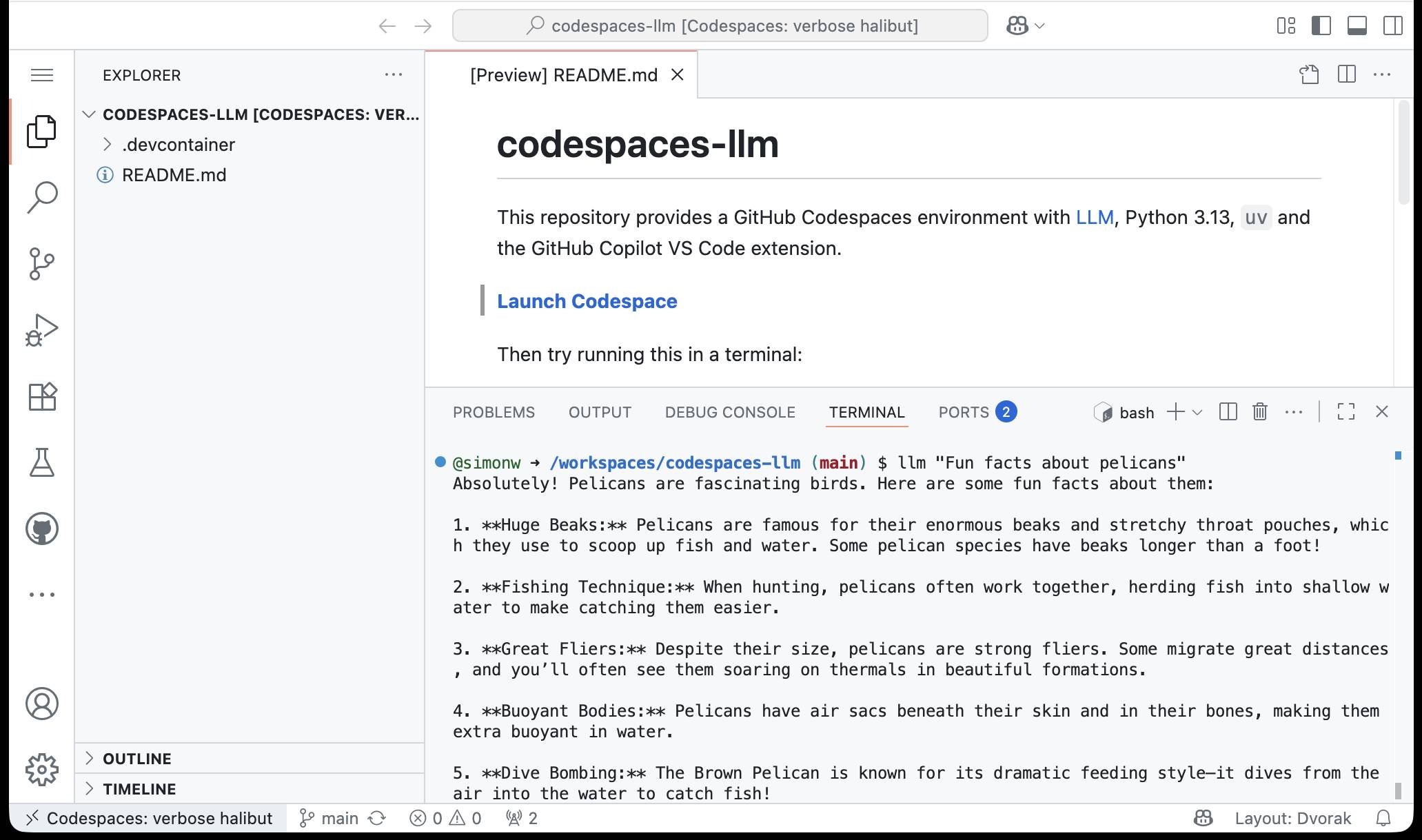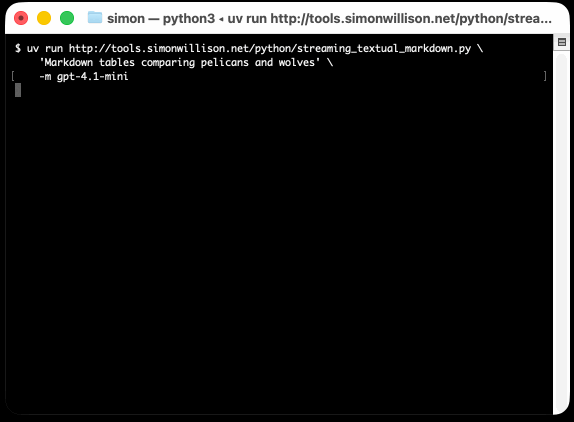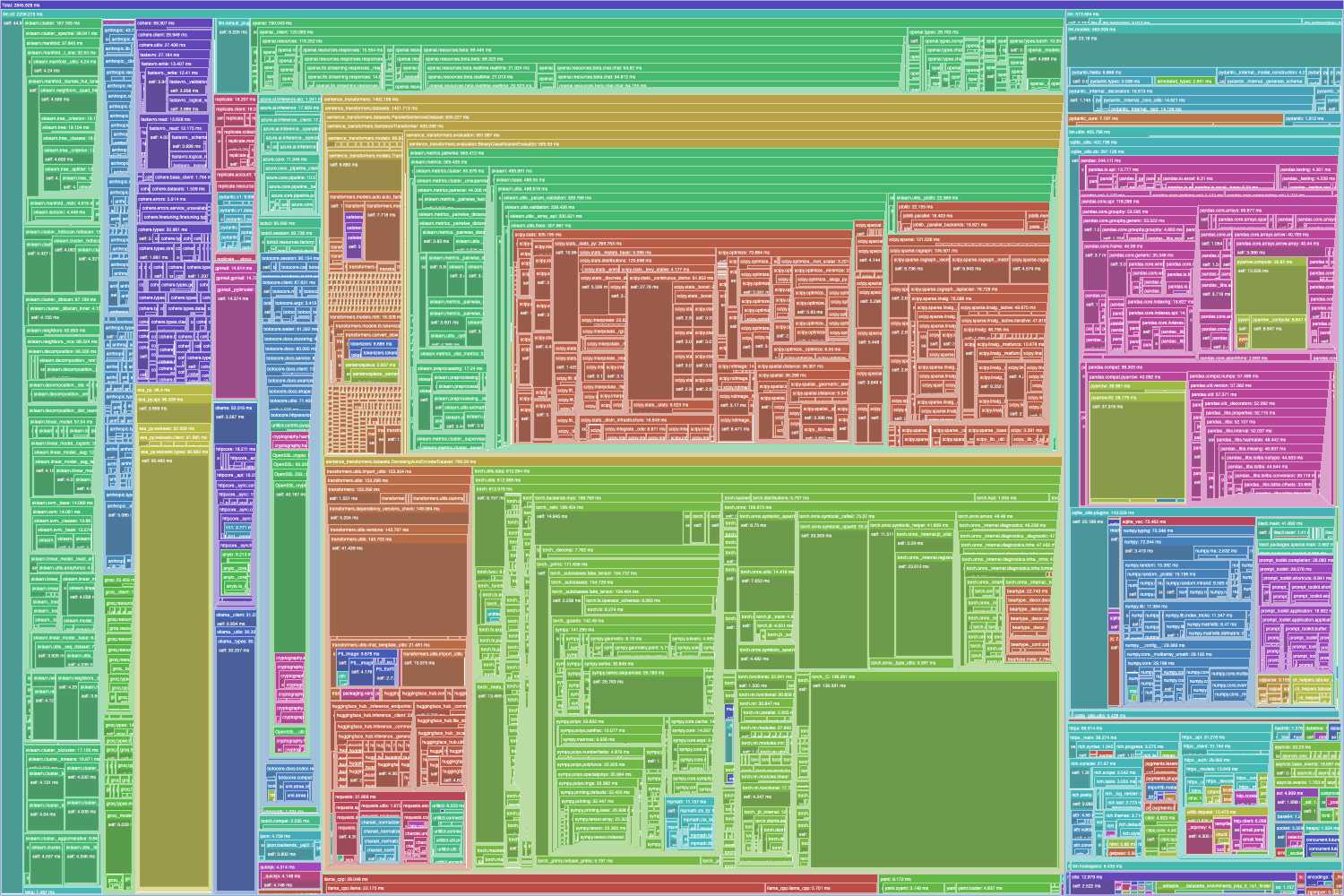1,211 posts tagged “python”
The Python programming language.
2025
Talk Python: Celebrating Django’s 20th Birthday With Its Creators. I recorded this podcast episode recently to celebrate Django's 20th birthday with Adrian Holovaty, Will Vincent, Jeff Triplet, and Thibaud Colas.
We didn’t know that it was a web framework. We thought it was a tool for building local newspaper websites. [...]
Django’s original tagline was ‘Web development on journalism deadlines’. That’s always been my favorite description of the project.
Python: The Documentary. New documentary about the origins of the Python programming language - 84 minutes long, built around extensive interviews with Guido van Rossum and others who were there at the start and during the subsequent journey.
Static Sites with Python, uv, Caddy, and Docker (via) Nik Kantar documents his Docker-based setup for building and deploying mostly static web sites in line-by-line detail.
I found this really useful. The Dockerfile itself without comments is just 8 lines long:
FROM ghcr.io/astral-sh/uv:debian AS build
WORKDIR /src
COPY . .
RUN uv python install 3.13
RUN uv run --no-dev sus
FROM caddy:alpine
COPY Caddyfile /etc/caddy/Caddyfile
COPY --from=build /src/output /srv/
He also includes a Caddyfile that shows how to proxy a subset of requests to the Plausible analytics service.
The static site is built using his sus package for creating static URL redirecting sites, but would work equally well for another static site generator you can install and run with uv run.
Nik deploys his sites using Coolify, a new-to-me take on the self-hosting alternative to Heroku/Vercel pattern which helps run multiple sites on a collection of hosts using Docker containers.
A bunch of the Hacker News comments dismissed this as over-engineering. I don't think that criticism is justified - given Nik's existing deployment environment I think this is a lightweight way to deploy static sites in a way that's consistent with how everything else he runs works already.
More importantly, the world needs more articles like this that break down configuration files and explain what every single line of them does.
Qwen-Image-Edit: Image Editing with Higher Quality and Efficiency.
As promised in their August 4th release of the Qwen image generation model, Qwen have now followed it up with a separate model, Qwen-Image-Edit, which can take an image and a prompt and return an edited version of that image.
Ivan Fioravanti upgraded his macOS qwen-image-mps tool (previously) to run the new model via a new edit command. Since it's now on PyPI you can run it directly using uvx like this:
uvx qwen-image-mps edit -i pelicans.jpg \
-p 'Give the pelicans rainbow colored plumage' -s 10
Be warned... it downloads a 54GB model file (to ~/.cache/huggingface/hub/models--Qwen--Qwen-Image-Edit) and appears to use all 64GB of my system memory - if you have less than 64GB it likely won't work, and I had to quit almost everything else on my system to give it space to run. A larger machine is almost required to use this.
I fed it this image:

The following prompt:
Give the pelicans rainbow colored plumage
And told it to use just 10 inference steps - the default is 50, but I didn't want to wait that long.
It still took nearly 25 minutes (on a 64GB M2 MacBook Pro) to produce this result:

To get a feel for how much dropping the inference steps affected things I tried the same prompt with the new "Image Edit" mode of Qwen's chat.qwen.ai, which I believe uses the same model. It gave me a result much faster that looked like this:

Update: I left the command running overnight without the -s 10 option - so it would use all 50 steps - and my laptop took 2 hours and 59 minutes to generate this image, which is much more photo-realistic and similar to the one produced by Qwen's hosted model:

Marko Simic reported that:
50 steps took 49min on my MBP M4 Max 128GB
PyPI: Preventing Domain Resurrection Attacks (via) Domain resurrection attacks are a nasty vulnerability in systems that use email verification to allow people to recover their accounts. If somebody lets their domain name expire an attacker might snap it up and use it to gain access to their accounts - which can turn into a package supply chain attack if they had an account on something like the Python Package Index.
PyPI now protects against these by treating an email address as not-validated if the associated domain expires.
Since early June 2025, PyPI has unverified over 1,800 email addresses when their associated domains entered expiration phases. This isn't a perfect solution, but it closes off a significant attack vector where the majority of interactions would appear completely legitimate.
This attack is not theoretical: it happened to the ctx package on PyPI back in May 2022.
Here's the pull request from April in which Mike Fiedler landed an integration which hits an API provided by Fastly's Domainr, followed by this PR which polls for domain status on any email domain that hasn't been checked in the past 30 days.
TIL: Running a gpt-oss eval suite against LM Studio on a Mac. The other day I learned that OpenAI published a set of evals as part of their gpt-oss model release, described in their cookbook on Verifying gpt-oss implementations.
I decided to try and run that eval suite on my own MacBook Pro, against gpt-oss-20b running inside of LM Studio.
TLDR: once I had the model running inside LM Studio with a longer than default context limit, the following incantation ran an eval suite in around 3.5 hours:
mkdir /tmp/aime25_openai
OPENAI_API_KEY=x \
uv run --python 3.13 --with 'gpt-oss[eval]' \
python -m gpt_oss.evals \
--base-url http://localhost:1234/v1 \
--eval aime25 \
--sampler chat_completions \
--model openai/gpt-oss-20b \
--reasoning-effort low \
--n-threads 2
My new TIL breaks that command down in detail and walks through the underlying eval - AIME 2025, which asks 30 questions (8 times each) that are defined using the following format:
{"question": "Find the sum of all integer bases $b>9$ for which $17_{b}$ is a divisor of $97_{b}$.", "answer": "70"}
pyx: a Python-native package registry, now in Beta (via) Since its first release, the single biggest question around the uv Python environment management tool has been around Astral's business model: Astral are a VC-backed company and at some point they need to start making real revenue.
Back in September Astral founder Charlie Marsh said the following:
I don't want to charge people money to use our tools, and I don't want to create an incentive structure whereby our open source offerings are competing with any commercial offerings (which is what you see with a lost of hosted-open-source-SaaS business models).
What I want to do is build software that vertically integrates with our open source tools, and sell that software to companies that are already using Ruff, uv, etc. Alternatives to things that companies already pay for today.
An example of what this might look like (we may not do this, but it's helpful to have a concrete example of the strategy) would be something like an enterprise-focused private package registry. [...]
It looks like those plans have become concrete now! From today's announcement:
TL;DR: pyx is a Python-native package registry --- and the first piece of the Astral platform, our next-generation infrastructure for the Python ecosystem.
We think of pyx as an optimized backend for uv: it's a package registry, but it also solves problems that go beyond the scope of a traditional "package registry", making your Python experience faster, more secure, and even GPU-aware, both for private packages and public sources (like PyPI and the PyTorch index).
pyx is live with our early partners, including Ramp, Intercom, and fal [...]
This looks like a sensible direction to me, and one that stays true to Charlie's promises to carefully design the incentive structure to avoid corrupting the core open source project that the Python community is coming to depend on.
simonw/codespaces-llm. GitHub Codespaces provides full development environments in your browser, and is free to use with anyone with a GitHub account. Each environment has a full Linux container and a browser-based UI using VS Code.
I found out today that GitHub Codespaces come with a GITHUB_TOKEN environment variable... and that token works as an API key for accessing LLMs in the GitHub Models collection, which includes dozens of models from OpenAI, Microsoft, Mistral, xAI, DeepSeek, Meta and more.
Anthony Shaw's llm-github-models plugin for my LLM tool allows it to talk directly to GitHub Models. I filed a suggestion that it could pick up that GITHUB_TOKEN variable automatically and Anthony shipped v0.18.0 with that feature a few hours later.
... which means you can now run the following in any Python-enabled Codespaces container and get a working llm command:
pip install llm
llm install llm-github-models
llm models default github/gpt-4.1
llm "Fun facts about pelicans"
Setting the default model to github/gpt-4.1 means you get free (albeit rate-limited) access to that OpenAI model.
To save you from needing to even run that sequence of commands I've created a new GitHub repository, simonw/codespaces-llm, which pre-installs and runs those commands for you.
Anyone with a GitHub account can use this URL to launch a new Codespaces instance with a configured llm terminal command ready to use:
codespaces.new/simonw/codespaces-llm?quickstart=1

While putting this together I wrote up what I've learned about devcontainers so far as a TIL: Configuring GitHub Codespaces using devcontainers.
LLM 0.27, the annotated release notes: GPT-5 and improved tool calling
I shipped LLM 0.27 today (followed by a 0.27.1 with minor bug fixes), adding support for the new GPT-5 family of models from OpenAI plus a flurry of improvements to the tool calling features introduced in LLM 0.26. Here are the annotated release notes.
[... 1,174 words]qwen-image-mps (via) Ivan Fioravanti built this Python CLI script for running the Qwen/Qwen-Image image generation model on an Apple silicon Mac, optionally using the Qwen-Image-Lightning LoRA to dramatically speed up generation.
Ivan has tested it this on 512GB and 128GB machines and it ran really fast - 42 seconds on his M3 Ultra. I've run it on my 64GB M2 MacBook Pro - after quitting almost everything else - and it just about manages to output images after pegging my GPU (fans whirring, keyboard heating up) and occupying 60GB of my available RAM. With the LoRA option running the script to generate an image took 9m7s on my machine.
Ivan merged my PR adding inline script dependencies for uv which means you can now run it like this:
uv run https://raw.githubusercontent.com/ivanfioravanti/qwen-image-mps/refs/heads/main/qwen-image-mps.py \
-p 'A vintage coffee shop full of raccoons, in a neon cyberpunk city' -f
The first time I ran this it downloaded the 57.7GB model from Hugging Face and stored it in my ~/.cache/huggingface/hub/models--Qwen--Qwen-Image directory. The -f option fetched an extra 1.7GB Qwen-Image-Lightning-8steps-V1.0.safetensors file to my working directory that sped up the generation.
Here's the resulting image:

Hypothesis is now thread-safe (via) Hypothesis is a property-based testing library for Python. It lets you write tests like this one:
from hypothesis import given, strategies as st @given(st.lists(st.integers())) def test_matches_builtin(ls): assert sorted(ls) == my_sort(ls)
This will automatically create a collection of test fixtures that exercise a large array of expected list and integer shapes. Here's a Gist demonstrating the tests the above code will run, which include things like:
[]
[0]
[-62, 13194]
[44, -19562, 44, -12803, -24012]
[-7531692443171623764, -109369043848442345045856489093298649615]
Hypothesis contributor Liam DeVoe was recently sponsored by Quansight to add thread safety to Hypothesis, which has become important recently due to Python free threading:
While we of course would always have loved for Hypothesis to be thread-safe, thread-safety has historically not been a priority, because running Hypothesis tests under multiple threads is not something we see often.
That changed recently. Python---as both a language, and a community---is gearing up to remove the global interpreter lock (GIL), in a build called free threading. Python packages, especially those that interact with the C API, will need to test that their code still works under the free threaded build. A great way to do this is to run each test in the suite in two or more threads simultaneously. [...]
Nathan mentioned that because Hypothesis is not thread-safe, Hypothesis tests in community packages have to be skipped when testing free threaded compatibility, which removes a substantial battery of coverage.
Now that Hypothesis is thread-safe another blocker to increased Python ecosystem support for free threading has been removed!
From Async/Await to Virtual Threads. Armin Ronacher has long been critical of async/await in Python, both for necessitating colored functions and because of the more subtle challenges they introduce like managing back pressure.
Armin argued convincingly for the threaded programming model back in December. Now he's expanded upon that with a description of how virtual threads might make sense in Python.
Virtual threads behave like real system threads but can vastly outnumber them, since they can be paused and scheduled to run on a real thread when needed. Go uses this trick to implement goroutines which can then support millions of virtual threads on a single system.
Python core developer Mark Shannon started a conversation about the potential for seeing virtual threads to Python back in May.
Assuming this proposal turns into something concrete I don't expect we will see it in a production Python release for a few more years. In the meantime there are some exciting improvements to the Python concurrency story - most notably around sub-interpreters - coming up this year in Python 3.14.
My 2.5 year old laptop can write Space Invaders in JavaScript now, using GLM-4.5 Air and MLX
I wrote about the new GLM-4.5 model family yesterday—new open weight (MIT licensed) models from Z.ai in China which their benchmarks claim score highly in coding even against models such as Claude Sonnet 4.
[... 685 words]TIL: Exception.add_note
(via)
Neat tip from Danny Roy Greenfeld: Python 3.11 added a .add_note(message: str) method to the BaseException class, which means you can add one or more extra notes to any Python exception and they'll be displayed in the stacktrace!
Here's PEP 678 – Enriching Exceptions with Notes by Zac Hatfield-Dodds proposing the new feature back in 2021.
Textual v4.0.0: The Streaming Release. Will McGugan may no longer be running a commercial company around Textual, but that hasn't stopped his progress on the open source project.
He recently released v4 of his Python framework for building TUI command-line apps, and the signature feature is streaming Markdown support - super relevant in our current age of LLMs, most of which default to outputting a stream of Markdown via their APIs.
I took an example from one of his tests, spliced in my async LLM Python library and got some help from o3 to turn it into a streaming script for talking to models, which can be run like this:
uv run http://tools.simonwillison.net/python/streaming_textual_markdown.py \
'Markdown headers and tables comparing pelicans and wolves' \
-m gpt-4.1-mini

Every day someone becomes a programmer because they figured out how to make ChatGPT build something. Lucky for us: in many of those cases the AI picks Python. We should treat this as an opportunity and anticipate an expansion in the kinds of people who might want to attend a Python conference. Yet many of these new programmers are not even aware that programming communities and conferences exist. It’s in the Python community’s interest to find ways to pull them in.
Reflections on OpenAI (via) Calvin French-Owen spent just over a year working at OpenAI, during which time the organization grew from 1,000 to 3,000 people and Calvin found himself in "the top 30% by tenure".
His reflections on leaving are fascinating - absolutely crammed with detail about OpenAI's internal culture that I haven't seen described anywhere else before.
I think of OpenAI as an organization that started like Los Alamos. It was a group of scientists and tinkerers investigating the cutting edge of science. That group happened to accidentally spawn the most viral consumer app in history. And then grew to have ambitions to sell to governments and enterprises.
There's a lot in here, and it's worth spending time with the whole thing. A few points that stood out to me below.
Firstly, OpenAI are a Python shop who lean a whole lot on Pydantic and FastAPI:
OpenAI uses a giant monorepo which is ~mostly Python (though there is a growing set of Rust services and a handful of Golang services sprinkled in for things like network proxies). This creates a lot of strange-looking code because there are so many ways you can write Python. You will encounter both libraries designed for scale from 10y Google veterans as well as throwaway Jupyter notebooks newly-minted PhDs. Pretty much everything operates around FastAPI to create APIs and Pydantic for validation. But there aren't style guides enforced writ-large.
ChatGPT's success has influenced everything that they build, even at a technical level:
Chat runs really deep. Since ChatGPT took off, a lot of the codebase is structured around the idea of chat messages and conversations. These primitives are so baked at this point, you should probably ignore them at your own peril.
Here's a rare peek at how improvements to large models get discovered and incorporated into training runs:
How large models are trained (at a high-level). There's a spectrum from "experimentation" to "engineering". Most ideas start out as small-scale experiments. If the results look promising, they then get incorporated into a bigger run. Experimentation is as much about tweaking the core algorithms as it is tweaking the data mix and carefully studying the results. On the large end, doing a big run almost looks like giant distributed systems engineering. There will be weird edge cases and things you didn't expect.
Happy 20th birthday Django! Here’s my talk on Django Origins from Django’s 10th
Today is the 20th anniversary of the first commit to the public Django repository!
[... 8,994 words]If you're running low on disk space and are a uv user, don't forget about uv cache prune:
uv cache pruneremoves all unused cache entries. For example, the cache directory may contain entries created in previous uv versions that are no longer necessary and can be safely removed.uv cache pruneis safe to run periodically, to keep the cache directory clean.
My Mac just ran out of space. I ran OmniDiskSweeper and noticed that the ~/.cache/uv directory was 63.4GB - so I ran this:
uv cache prune
Pruning cache at: /Users/simon/.cache/uv
Removed 1156394 files (37.3GiB)
And now my computer can breathe again!
awwaiid/gremllm (via) Delightfully cursed Python library by Brock Wilcox, built on top of LLM:
from gremllm import Gremllm counter = Gremllm("counter") counter.value = 5 counter.increment() print(counter.value) # 6? print(counter.to_roman_numerals()) # VI?
You tell your Gremllm what it should be in the constructor, then it uses an LLM to hallucinate method implementations based on the method name every time you call them!
This utility class can be used for a variety of purposes. Uhm. Also please don't use this and if you do please tell me because WOW. Or maybe don't tell me. Or do.
Here's the system prompt, which starts:
You are a helpful AI assistant living inside a Python object called '{self._identity}'.
Someone is interacting with you and you need to respond by generating Python code that will be eval'd in your context.
You have access to 'self' (the object) and can modify self._context to store data.
Tip: Use keyword-only arguments in Python dataclasses
(via)
Useful tip from Christian Hammond: if you create a Python dataclass using @dataclass(kw_only=True) its constructor will require keyword arguments, making it easier to add additional properties in the future, including in subclasses, without risking breaking existing code.
My First Open Source AI Generated Library (via) Armin Ronacher had Claude and Claude Code do almost all of the work in building, testing, packaging and publishing a new Python library based on his design:
- It wrote ~1100 lines of code for the parser
- It wrote ~1000 lines of tests
- It configured the entire Python package, CI, PyPI publishing
- Generated a README, drafted a changelog, designed a logo, made it theme-aware
- Did multiple refactorings to make me happier
The project? sloppy-xml-py, a lax XML parser (and violation of everything the XML Working Group hold sacred) which ironically is necessary because LLMs themselves frequently output "XML" that includes validation errors.
Claude's SVG logo design is actually pretty decent, turns out it can draw more than just bad pelicans!
I think experiments like this are a really valuable way to explore the capabilities of these models. Armin's conclusion:
This was an experiment to see how far I could get with minimal manual effort, and to unstick myself from an annoying blocker. The result is good enough for my immediate use case and I also felt good enough to publish it to PyPI in case someone else has the same problem.
Treat it as a curious side project which says more about what's possible today than what's necessarily advisable.
I'd like to present a slightly different conclusion here. The most interesting thing about this project is that the code is good.
My criteria for good code these days is the following:
- Solves a defined problem, well enough that I'm not tempted to solve it in a different way
- Uses minimal dependencies
- Clear and easy to understand
- Well tested, with tests prove that the code does what it's meant to do
- Comprehensive documentation
- Packaged and published in a way that makes it convenient for me to use
- Designed to be easy to maintain and make changes in the future
sloppy-xml-py fits all of those criteria. It's useful, well defined, the code is readable with just about the right level of comments, everything is tested, the documentation explains everything I need to know, and it's been shipped to PyPI.
I'd be proud to have written this myself.
This example is not an argument for replacing programmers with LLMs. The code is good because Armin is an expert programmer who stayed in full control throughout the process. As I wrote the other day, a skilled individual with both deep domain understanding and deep understanding of the capabilities of the agent.
python-importtime-graph.
I was exploring why a Python tool was taking over a second to start running and I learned about the python -X importtime feature, documented here. Adding that option causes Python to spit out a text tree showing the time spent importing every module.
I tried that like this:
python -X importtime -m llm plugins
That's for LLM running 41 different plugins. Here's the full output from that command, which starts like this:
import time: self [us] | cumulative | imported package
import time: 77 | 77 | _io
import time: 19 | 19 | marshal
import time: 131 | 131 | posix
import time: 363 | 590 | _frozen_importlib_external
import time: 450 | 450 | time
import time: 110 | 559 | zipimport
import time: 64 | 64 | _codecs
import time: 252 | 315 | codecs
import time: 277 | 277 | encodings.aliases
Kevin Michel built this excellent tool for visualizing these traces as a treemap. It runs in a browser - visit kmichel.github.io/python-importtime-graph/ and paste in the trace to get the visualization.
Here's what I got for that LLM example trace:

As you can see, it's pretty dense! Here's the SVG version which is a lot more readable, since you can zoom in to individual sections.
Zooming in it looks like this:

I counted all of the yurts in Mongolia using machine learning (via) Fascinating, detailed account by Monroe Clinton of a geospatial machine learning project. Monroe wanted to count visible yurts in Mongolia using Google Maps satellite view. The resulting project incorporates mercantile for tile calculations, Label Studio for help label the first 10,000 examples, a model trained on top of YOLO11 and a bunch of clever custom Python code to co-ordinate a brute force search across 120 CPU workers running the model.
The Steering Council (SC) approves PEP 779 [Criteria for supported status for free-threaded Python], with the effect of removing the “experimental” tag from the free-threaded build of Python 3.14 [...]
With these recommendations and the acceptance of this PEP, we as the Python developer community should broadly advertise that free-threading is a supported Python build option now and into the future, and that it will not be removed without following a proper deprecation schedule. [...]
Keep in mind that any decision to transition to Phase III, with free-threading as the default or sole build of Python is still undecided, and dependent on many factors both within CPython itself and the community. We leave that decision for the future.
— Donghee Na, discuss.python.org
llm-mistral 0.14. I added tool-support to my plugin for accessing the Mistral API from LLM today, plus support for Mistral's new Codestral Embed embedding model.
An interesting challenge here is that I'm not using an official client library for llm-mistral - I rolled my own client on top of their streaming HTTP API using Florimond Manca's httpx-sse library. It's a very pleasant way to interact with streaming APIs - here's my code that does most of the work.
The problem I faced is that Mistral's API documentation for function calling has examples in Python and TypeScript but doesn't include curl or direct documentation of their HTTP endpoints!
I needed documentation at the HTTP level. Could I maybe extract that directly from Mistral's official Python library?
It turns out I could. I started by cloning the repo:
git clone https://github.com/mistralai/client-python
cd client-python/src/mistralai
files-to-prompt . | ttokMy ttok tool gave me a token count of 212,410 (counted using OpenAI's tokenizer, but that's normally a close enough estimate) - Mistral's models tap out at 128,000 so I switched to Gemini 2.5 Flash which can easily handle that many.
I ran this:
files-to-prompt -c . > /tmp/mistral.txt
llm -f /tmp/mistral.txt \
-m gemini-2.5-flash-preview-05-20 \
-s 'Generate comprehensive HTTP API documentation showing
how function calling works, include example curl commands for each step'The results were pretty spectacular! Gemini 2.5 Flash produced a detailed description of the exact set of HTTP APIs I needed to interact with, and the JSON formats I should pass to them.
There are a bunch of steps needed to get tools working in a new model, as described in the LLM plugin authors documentation. I started working through them by hand... and then got lazy and decided to see if I could get a model to do the work for me.
This time I tried the new Claude Opus 4. I fed it three files: my existing, incomplete llm_mistral.py, a full copy of llm_gemini.py with its working tools implementation and a copy of the API docs Gemini had written for me earlier. I prompted:
I need to update this Mistral code to add tool support. I've included examples of that code for Gemini, and a detailed README explaining the Mistral format.
Claude churned away and wrote me code that was most of what I needed. I tested it in a bunch of different scenarios, pasted problems back into Claude to see what would happen, and eventually took over and finished the rest of the code myself. Here's the full transcript.
I'm a little sad I didn't use Mistral to write the code to support Mistral, but I'm pleased to add yet another model family to the list that's supported for tool usage in LLM.
Build AI agents with the Mistral Agents API. Big upgrade to Mistral's API this morning: they've announced a new "Agents API". Mistral have been using the term "agents" for a while now. Here's how they describe them:
AI agents are autonomous systems powered by large language models (LLMs) that, given high-level instructions, can plan, use tools, carry out steps of processing, and take actions to achieve specific goals.
What that actually means is a system prompt plus a bundle of tools running in a loop.
Their new API looks similar to OpenAI's Responses API (March 2025), in that it now manages conversation state server-side for you, allowing you to send new messages to a thread without having to maintain that local conversation history yourself and transfer it every time.
Mistral's announcement captures the essential features that all of the LLM vendors have started to converge on for these "agentic" systems:
- Code execution, using Mistral's new Code Interpreter mechanism. It's Python in a server-side sandbox - OpenAI have had this for years and Anthropic launched theirs last week.
- Image generation - Mistral are using Black Forest Lab FLUX1.1 [pro] Ultra.
- Web search - this is an interesting variant, Mistral offer two versions:
web_searchis classic search, butweb_search_premium"enables access to both a search engine and two news agencies: AFP and AP". Mistral don't mention which underlying search engine they use but Brave is the only search vendor listed in the subprocessors on their Trust Center so I'm assuming it's Brave Search. I wonder if that news agency integration is handled by Brave or Mistral themselves? - Document library is Mistral's version of hosted RAG over "user-uploaded documents". Their documentation doesn't mention if it's vector-based or FTS or which embedding model it uses, which is a disappointing omission.
- Model Context Protocol support: you can now include details of MCP servers in your API calls and Mistral will call them when it needs to. It's pretty amazing to see the same new feature roll out across OpenAI (May 21st), Anthropic (May 22nd) and now Mistral (May 27th) within eight days of each other!
They also implement "agent handoffs":
Once agents are created, define which agents can hand off tasks to others. For example, a finance agent might delegate tasks to a web search agent or a calculator agent based on the conversation's needs.
Handoffs enable a seamless chain of actions. A single request can trigger tasks across multiple agents, each handling specific parts of the request.
This pattern always sounds impressive on paper but I'm yet to be convinced that it's worth using frequently. OpenAI have a similar mechanism in their OpenAI Agents SDK.
2025 Python Packaging Ecosystem Survey. If you make use of Python packaging tools (pip, Anaconda, uv, dozens of others) and have opinions please spend a few minutes with this year's packaging survey. This one was "Co-authored by 30+ of your favorite Python Ecosystem projects, organizations and companies."
django-simple-deploy. Eric Matthes presented a lightning talk about this project at PyCon US this morning. "Django has a deploy command now". You can run it like this:
pip install django-simple-deploy[fly_io]
# Add django_simple_deploy to INSTALLED_APPS.
python manage.py deploy --automate-all
It's plugin-based (inspired by Datasette!) and the project has stable plugins for three hosting platforms: dsd-flyio, dsd-heroku and dsd-platformsh.
Currently in development: dsd-vps - a plugin that should work with any VPS provider, using Paramiko to connect to a newly created instance and run all of the commands needed to start serving a Django application.
Today I learned - from a very short "we're sponsoring Python" sponsor blurb by Meta during the opening PyCon US welcome talks - that Python is now "the most-used language at Meta" - if you consider all of the different functional areas spread across the company.
They also have "over 3,000 Python developers working in the language every day".

The live captions for the event are once again provided by the excellent White Coat Captioning - real human beings! This got a cheer when it was pointed out by the conference chair a few moments earlier.

